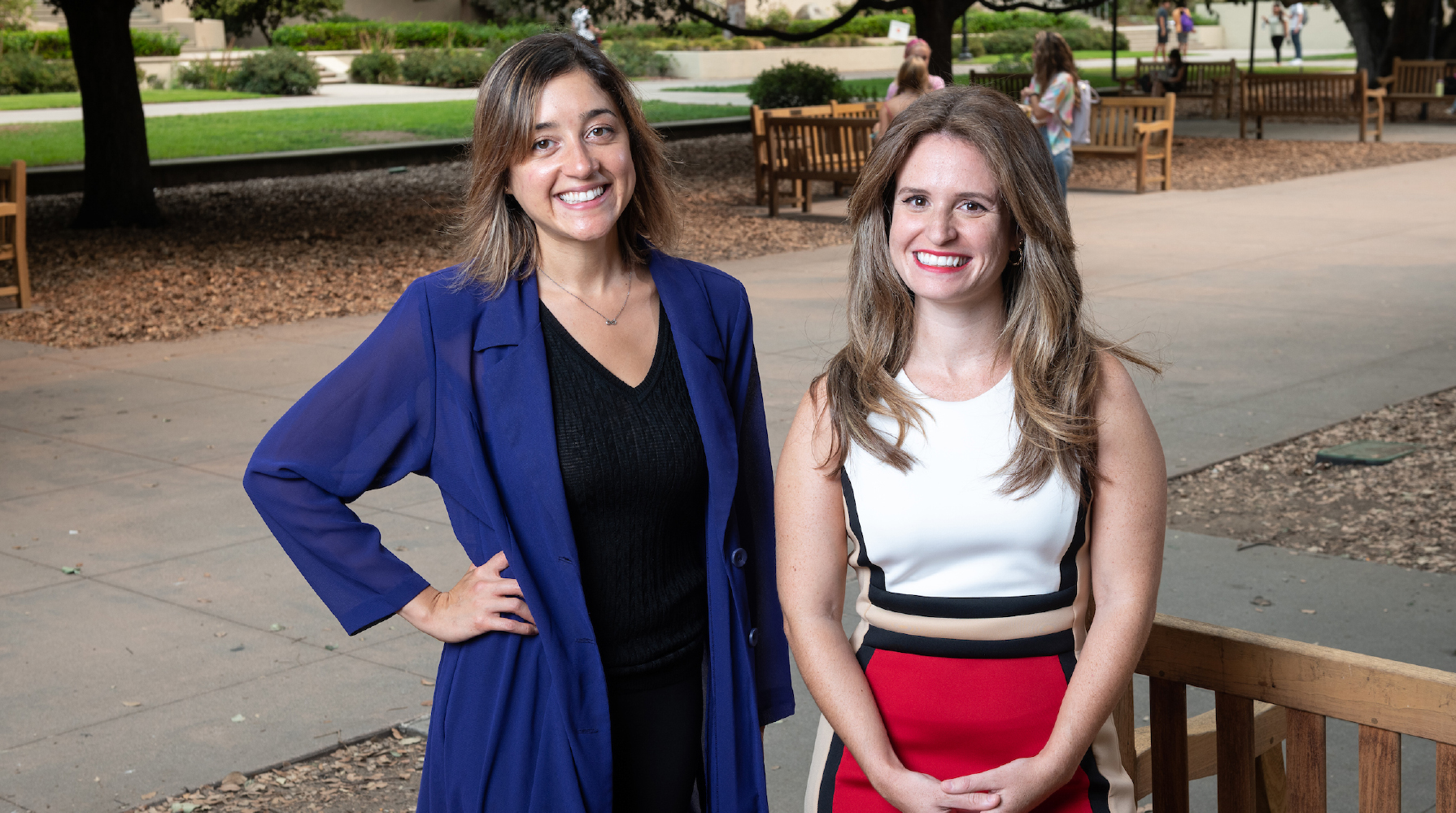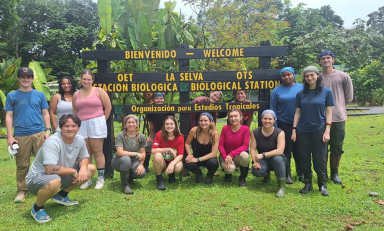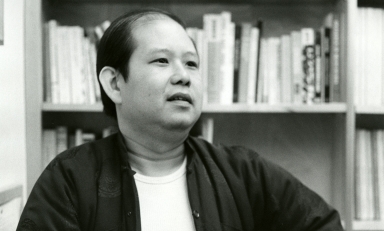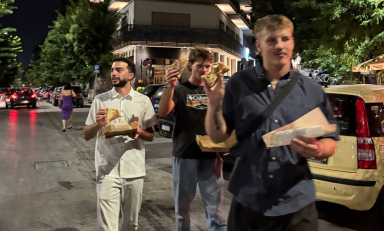
A Q&A with assistant professors Stephanie Nelli (cognitive science) and Celia Martínez-Sáez (Spanish literature and culture)
When Oxy students returned to in-person studies in the fall, they were joined by two new tenure-track faculty on campus—and it's hard to tell who was happier.
“It feels incredible to be in the classroom,” says Celia Martínez-Sáez, assistant professor of Spanish literature and culture. "As a very social person, losing human contact with my students and colleagues for the last year and a half was very hard. Now, I appreciate in-person connections even more, and I believe students do too. I recognize the importance and usefulness of technology in today’s world, but the effect of people sharing ideas and feelings in the same space is irreplaceable."
Martínez-Sáez teaches courses on contemporary culture and literature in Spain, mass media, gender and sexuality, and film. Her research interests include Spanish national identity in the 21st century, theater, race in contemporary Spain, and gender with a particular focus on masculinities in popular culture, especially film and TV series. She has a Ph.D. in Iberian and Latin American literatures and cultures from Ohio State University, a master’s in Iberian studies from Ohio State, and a B.A. in English studies from the University of Alicante.
For Stephanie Nelli, assistant professor of cognitive science, being back in the classroom has been “invigorating. I missed live lecturing and whiteboarding a lot—as my students could probably tell,” she notes. “Online learning has certainly been great for democratizing the learning experience in many regards, but I don’t think anything can replace the experiences you get face-to-face—be it in the classroom, laboratory, office hours, or simply walking around campus and feeling the electric energy.”
Nelli has a B.A. in mathematics from the University of North Carolina at Chapel Hill and a Ph.D. in computational neuroscience from UC San Diego. Before coming to Oxy, she was a postdoctoral researcher in the human information processing lab at the University of Oxford, where she studied the computational principles underlying rapid learning and flexible decision-making in novel environments.
In a short Q&A with Occidental magazine, Martínez-Sáez and Nelli discuss their academic journeys, their current research and projects, and their impressions of Oxy after a fulfilling fall semester.
What attracted you to Occidental?
Martínez-Sáez: Everything! I love the fact that Oxy is a small liberal arts college that values creativity, innovation, and close and long-lasting relationships with students. And, on top of that, it is in one of the most vibrant cities in the world. I felt really drawn to the sense of community on campus and the endless possibilities of working with students and other faculty members.
Nelli: We truly have the best of both worlds: small classrooms and a community feel—both in a dynamic metropolitan setting. It has been exciting to expose Oxy students who may not feel they belong in STEM, just due to cultural messaging, to neuroscience and computer science. Because the school is small, I have been able to get to know my students on a personal level, and take joy in being able to watch my students’ interests and understanding grow. On top of that, Occidental has access to tons of resources due to its location, one of my favorites being the vibrant community-based programming at Oxy Arts. Finally, I am excited about the potential for my lab’s research to continue to grow and evolve through the resources provided by Oxy’s Undergraduate Research Center, as well as relationships within the rich scholarly environment of Los Angeles.
What are your impressions of Oxy in general?
Nelli: I love how Occidental students are intelligent and detail-oriented, but still open-minded and eager to make cross-disciplinary connections. That is the essence of the liberal arts education. The student body is so close-knit—Oxy’s students can depend on the safety net of this community, which is so invaluable in college, especially in times like this. On top of this, Oxy students are incredibly well-rounded and engaged in everything from pressing social justice issues to the latest fashion trends.
Martínez-Sáez: I’ve only worked here for one semester, and I already know so many students and faculty at Oxy. I love going around campus saying “Hola” and “hi” to everybody. Oxy really feels like family. I’ve already met so many interesting professors from diverse disciplines, who inspire me to pursue intellectual and artistic projects both inside and outside the classroom. Regarding the students, I’ve never had so many come to my office. They are intellectually curious, active, creative, and they love to think outside of the box. My first impressions of Oxy could not be more positive.
Celia, where did you develop an interest in contemporary Spanish culture and literature?
Martínez-Sáez: Being from Spain, I was always interested in the literature and culture from my country. However, I did my B.A. in English literature in Alicante, Spain. When I finished my B.A., I moved to the United States to teach Spanish and pursue a master’s degree. It was precisely in the U.S. where I developed a passion for the study of Spanish literature and culture. Studying Spanish literature and culture from outside Spain gave me a whole new perspective that I think I needed. I started to analyze my country’s cultural nuances and be more critical of them, while appreciating its beauty and singularity.
You have published award-winning poetry and are active in community-based Spanish-language theater. Are you currently at work on anything?
Martínez-Sáez: My poetry book Nosotras las desterradas (Displaced Women) is currently under review by a prestigious publishing house. This book deals with the experience of leaving one’s homeland, building a life from scratch as a migrant, and women’s expectations in our postmodern society. I’ve been working on this project for a few years, so it’s very exciting.
Stephanie, where did you develop an interest in cognitive science?
Nelli: As a child, I was fascinated by the question of whether my color “blue” was the same as everyone else’s. Everyone was creating their own private worlds inside their heads and I wanted to peek into each and every one of them! In high school, I was interested in becoming a psychologist but then took a calculus class my senior year. I had been a pretty poor mathematics student up until then, but in those classes I became entirely enamored with the concept of infinity. That same year I took several philosophy classes, which showed me how the same type of logical reasoning I was using in my mathematics classes could be deployed to understand difficult-to-define concepts like agency and consciousness.
In college, I completed a mathematics major while doing research in psychology and neuroscience, and continued along these lines in graduate school and my postdoctoral research. Cognitive science rests upon a foundation of mathematics, psychology, philosophy, and computer science, among other subjects, and so I was thrilled when I saw Occidental’s job advertisement.
You have researched and talked extensively about visual information processing. What exactly does that entail?
Nelli: When you think about it, visual perception is a miracle. How does our brain make sense of the world? There is plenty of evidence that visual perception involves many more “top-down” mechanisms than we ever thought—our brain fills in so many gaps. In a given moment, most of what we are perceiving is what we expect to see, as opposed to what is truly in front of us.
More generally, I am interested in comparing the coding schemes used in the human brain with those that emerge in artificial neural network models to glean more general computational principles. What is necessary and sufficient for supporting complex behavior and intelligence? Visual perception is a relatively extensively studied field in neuroscience, and so it is fertile ground for testing and validating models.
I have since begun to take this approach beyond visual perception into the domain of learning and inference—imagine figuring out how to use foreign coins when traveling, or operating a strange shower in a hotel room. Do similar “top-down” mechanisms help us make novel decisions in this complex and ever-changing world?
Anything else you’d like to add?
Martínez-Sáez: I am currently working on recruiting students to create a theater club in Spanglish with the Latinx community at Oxy and Spanish-speaking students. This would be a dream come true.
Nelli: I’m thrilled to be here.



